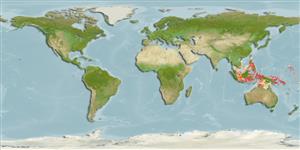>
Gobiiformes (Gobies) >
Gobiidae (Gobies) > Gobiinae
Etymology: Eviota: No etymology given, suggested by Christopher Scharpt: from Latin 'eu' for 'true' and 'iota' for anything very small, in combination 'truly very small' referring to it as being the smallest vertebrate at the time it has benn described by Jenkins (thus, making the suggestion by Scharpt plausible; jewettae: Named for Susan L. Jewett, who previously recognized this species as undescribed from specimens taken by the Smithsonian Philippine Expedition in 1978.
Eponymy: Susan Lee Jewett (formerly Susan J Karnella) (d: 1945) is an American ichthyologist who was Collections Manager, Division of Fishes, Smithsonian Institution. [...] (Ref. 128868), visit book page.
Environment: milieu / climate zone / depth range / distribution range
Ecologia
marino associati a barriera corallina; distribuzione batimetrica 7 - 33 m (Ref. 92345). Tropical
Distribuzione
Stati | Aree FAO | Ecosystems | Presenze | Point map | Introduzioni | Faunafri
Western Pacific: known from Palau (only from Helen Reef, the southern-most of the South West Islands), Philippine Islands, Papua New Guinea and Raja Ampat, Indonesia.
Size / Peso / Age
Maturity: Lm ? range ? - ? cm
Max length : 1.2 cm SL maschio/sesso non determinato; (Ref. 92345); 1.2 cm SL (female)
Short description
Chiavi di identificazione | Morfologia | Morfometria
Spine dorsali (totale) : 6; Raggi dorsali molli (totale) : 8; Spine anali: 1; Raggi anali molli: 8. This species is distinguished from congeners by the following set of characters: cephalic sensory-pore system lacking all pores 98% of the time; dorsal/anal fin-ray formula 8/8; pectoral-fin rays 15-16, ventralmost two rays unbranched with at least 2 (but up to 4) lower rays branched at tips above this, remainder of rays unbranched; 4th pelvic-fin ray bifurcated with each branch about 60% of total length of the ray; unbranched 5th pelvic-fin ray 13-20% of 4th; non-filamentous dorsal-fin spines, tubular anterior nares short, less than ½ pupil diameter in length; when alive, body is translucent and crossed by five broad orange to red bands (Ref. 82345).
Life cycle and mating behavior
Maturità | Riproduzione | Deposizione | Uova | Fecundity | Larve
Greenfield, D.W. and R. Winterbottom, 2012. Two new dwarfgobies from the Southwestern Pacific Ocean (Teleostei: Gobiidae: Eviota). Zootaxa 3572:33-42. (Ref. 92345)
IUCN Red List Status (Ref. 130435: Version 2024-1)
Threat to humans
Harmless
Human uses
Strumenti
Special reports
Download XML
Fonti Internet
Estimates based on models
Preferred temperature (Ref.
123201): 28 - 29.1, mean 28.6 °C (based on 62 cells).
Phylogenetic diversity index (Ref.
82804): PD
50 = 0.5000 [Uniqueness, from 0.5 = low to 2.0 = high].
Bayesian length-weight: a=0.01023 (0.00477 - 0.02194), b=3.01 (2.83 - 3.19), in cm total length, based on LWR estimates for this (Sub)family-body shape (Ref.
93245).
Trophic level (Ref.
69278): 3.0 ±0.3 se; based on size and trophs of closest relatives
Fishing Vulnerability (Ref.
59153): Low vulnerability (10 of 100).
